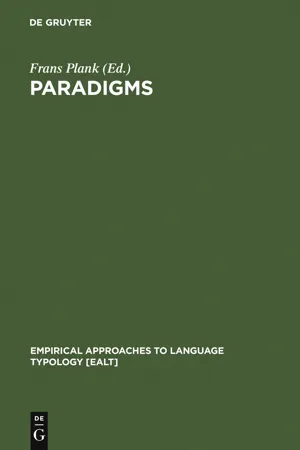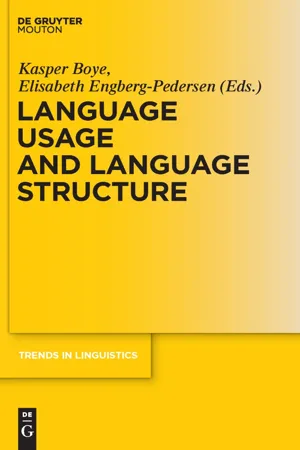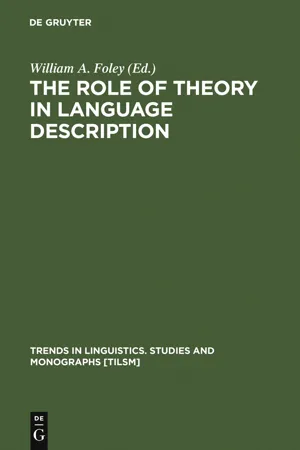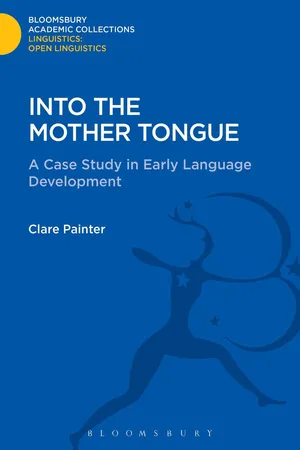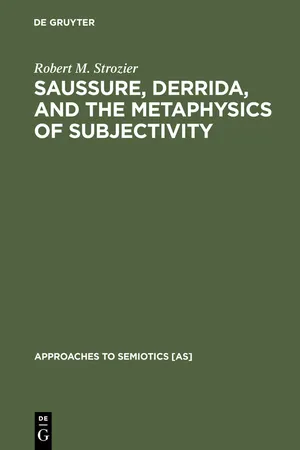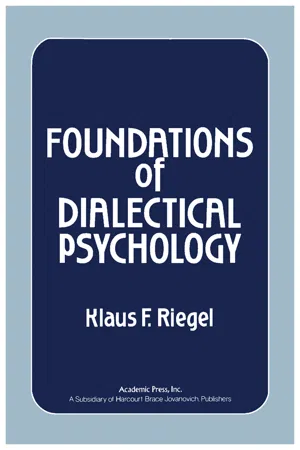Languages & Linguistics
Paradigmatic Relations
Paradigmatic relations refer to the relationship between elements within a linguistic system that can be substituted for one another. These elements are typically related by sharing a common grammatical or semantic category. For example, in English, the words "cat," "dog," and "bird" are paradigmatically related as they all belong to the category of animals.
Written by Perlego with AI-assistance
11 Key excerpts on "Paradigmatic Relations"
- Uwe Junghanns, Luka Szucsich, Uwe Junghanns, Luka Szucsich(Authors)
- 2011(Publication Date)
- De Gruyter Mouton(Publisher)
These relationships may be purely semantic (for example, agent, patient, beneficiary) or they may represent different levels of linguistic structure: syntagmatic (subject, direct or indirect object, predicate, complement) or paradigmatic (case, gender, person). The latter enter into larger classes of morphosyntactic relationships, known as grammatical categories ... (p. 107) 2 Tania Avgustinova While Paradigmatic Relations are functional contrasts and involve dif-ferentiation, syntagmatic relations are possibilities of combination of interacting items chosen within a framework of rules and conventions (both explicit and implicit), e.g., on the basis of a grammar system. They link together elementary constituent segments or minimal signifi-cant units which themselves belong to various paradigms. Mature lin-guistic theories develop nowadays powerful ontologies for linguistic objects and categories (like words, phrases, sentences) as well as rich inventories of relations among properties of these objects (e.g., agree-ment, subcategorisation, long-distance dependencies, etc.). Yet, no consistent account of grammatically relevant relations can be found. The key hypothesis put forward here is that systematic relations mo-tivate shared patterns of variation cross-linguistically as well as across constructions. To adequately encode the metagrammar of systematic relations, we need an ontological level of grammatical abstraction. This ontological level can be encoded as compatible multidimensional hier-archies of types of linguistic entities, with constraint inheritance from more general to more specific types. In short, the hierarchy allows for the expression of (possibly cross-cutting) generalisations and a specifi-cation of (in)compatibility between types. The generalisations are captured by factoring them out as constraints on super-types, as well as allowing types to have more than one super-type.- (Author)
- 2015(Publication Date)
- Cuvillier Verlag(Publisher)
Such linear combinations in discourse are called ‘syntagms’. “In the syntagm a term acquires its value only because it stands in opposition to everything that precedes or follows it” ([1916] 1960: 123). At the same time every element of a syntagm stands in a paradigmatic relation to any other element that could take its place in the same syntagm according to the rules of the language system. Saussure called such relations ‘associative’ because they were based on the association between a present element and absent ones that could fulfil the same function within the syntagm, i.e. replace the former. Syntagmatic and Paradigmatic Relations are associated with a horizontal and a vertical perspective towards language. They structure the language system and reveal aspects of meaning and lexical dependencies. Sinclair deals with the same issue of language interpretation. He states that on a rather abstract semantic level, meaning can be assigned to words or word-classes by being chosen among others, which is called ‘paradigmatic choice’. Additionally, words usually take part in the realisation of a larger item or unit, Dieses Werk ist copyrightgeschützt und darf in keiner Form vervielfältigt werden noch an Dritte weitergegeben werden. Es gilt nur für den persönlichen Gebrauch. 19 defined as ‘syntagmatic relation’ (cf. Sinclair 1998: 14). Sinclair/Mauranen (2006: 134) put this as follows: A text forms along the syntagmatic axis and consists of a string of items chosen from what is available on the paradigmatic axis. Traditional linguistic theory had put an emphasis on paradigmatic choice for quite a long time, which led to single words being associated with too much independent meaning while neglecting their environment. It focused on the segmentation and classification of decontextualised entities. Contextualism, on the other hand, relies its language description on contextualised entities and hence on the observation of syntagmatic relations, too.- eBook - PDF
- Geert E. Booij, Christian Lehmann, Joachim Mugdan, Geert E. Booij, Christian Lehmann, Joachim Mugdan(Authors)
- 2008(Publication Date)
- De Gruyter Mouton(Publisher)
Syntagmatic relationships hold between the constituent elements of a given linguistic unit (word, phrase, sentence). In contrast to the syntagmatic axis of language, the nature of the paradigmatic axis was far less clear. In consequence of the fact that in the Cours the Paradigmatic Relationships lacked a general characterization, their con-ceptual status was not made clear at all. This may be connected to the fact that the para-digmatic axis seems to be less manifest than its syntagmatic counterpart (cf. 2). In addi-tion, the Paradigmatic Relationships were characterized in psychological rather than in linguistic terms: as we have seen, they were called “associative” while they were consid-ered to bear upon “mnemonic series”. In a way, the rather unclear status of the Paradigmatic Relationships is quite surpris-ing. There seems to be no doubt that the par-adigmatic axis of language bears upon the phenomenon of “linguistic relatedness” (Van Marle 1992). In other words, Paradigmatic Relationships deal with the ways in which lin-guistic entities may be mutually connected, both formally and/or semantically (cf. 2). Evidently, there is no necessity to define this phenomenon in predominantly psychological terms, just as the syntagmatic relationships must not be exclusively defined in terms of e.g. speech production. That is, the paradig-matic axis of language, like its syntagmatic counterpart, can and must be characterized in purely linguistic terms. 2. Linguistic relatedness In addition to the little transparent way in which the paradigmatic axis of language was introduced in the Cours , the actual treatment of the Paradigmatic Relationships has caused confusion as well. In the Cours the paradig-matic axis of language is illustrated with the help of the ramifications of enseignement , compare Fig. 24.1. enseignement clément justement etc. etc. changement armement etc. etc. enseigner enseignons etc. etc. apprentisage éducation etc. - eBook - PDF
Paradigms
The Economy of Inflection
- Frans Plank(Author)
- 2011(Publication Date)
- De Gruyter Mouton(Publisher)
Syncretism and the paradigmatic patterning of grammatical meaning Jadranka Gvozdanovic 1. Form-meaning relations and paradigms In a language one form may be associated with either one meaning (with possible contextually bound variants) or with two or more distinct meanings. The distinct meanings may be either mutually related or unrelated, and if related, either opposed or contrasted. Mutually related meanings of a language and the forms associated with them constitute paradigms. Defined as a set of mutually related meanings and the corresponding forms, the notion paradigm is applicable both to grammatical and to lexical meanings. Relevant research questions concerning paradigms are the following: — when are two or more meanings mutually related, i. e., when do they participate in the same paradigm, and — what kind of relations may occur within a paradigm and how are we able to detect them? An investigation of meanings which may constitute a paradigm, and be mutually related in various ways within a paradigm, can best proceed (a) by studying meanings and relations among meanings in obvious paradigms, and then (b) by studying meanings and relations among meanings which do not constitute obvious paradigms, so as to establish the meaning traits which are connected with paradigms. Given the general definition of paradigms as sets of mutually related meanings and the corresponding forms, this procedure should be applicable to grammatical and to lexical meanings, notwithstanding the fact that grammatical meanings arc relational and constitute synchronically finite sets, whereas lexical meanings are neither entirely relational nor do they constitute finite sets at any point of time (i. e., their creative extension is always possible in language use). - Jaap van Marle(Author)
- 2017(Publication Date)
- De Gruyter(Publisher)
13 functioning of these relationships will be dealt with in the later chapters. Some short notes, finally, with respect to the prominent position that was - at least, theoretically - assigned to the Paradigmatic Relationships within the various approaches to grammatical structure by European structuralists. One of the common characteristics of the European structuralist schools is, that language is considered to be a system in which the value of the individual ele-ments is by and large - or even completely - determined by their 'position' within the system as a whole (cf. chapter 3 for some discussion). 26 Evidently, this - in combination with other factors (cf. Kaldeway & Koefoed, 1979: 96) -is one of the results of the Saussurean conception of language, according to which the 'langue' is a system - to use Meillet's famous wording - où tout se tient. 29 For, given the general Saussurean idea of the langue as un système de signes (CLG: 32), for which it holds that the 'valeur' of each element is determined by its relationships with the other elements in the system (cf. CLG: 126, 160-161), it is obvious that the relationships between the various elements of the system became the prime domain of linguistic investigation. 30 From the above it will be clear that these relationships are paradigmatic in nature. The above conception of 'system' and the prominent position of the para-digmatic relationships seems to be an overall characteristic of European struc-turalism. Uhlenbeck, in his overview of structural linguistics, considers the most fundamental trait to be the insight that it is not the elements themselves which constitute the prime interest of the linguist, but the relationships of these elements with the other entities in the system (Dhlenbeck, 1974: 150).- eBook - PDF
- Kasper Boye, Elisabeth Engberg-Pedersen, Kasper Boye, Elisabeth Engberg-Pedersen(Authors)
- 2010(Publication Date)
- De Gruyter Mouton(Publisher)
The word ‘paradigm’ is absent from for instance Bybee, Perkins and Pagliuca (1993), and expectedly so, since these authors subscribe to the view that structure is epiphenomenal (1993:1), and in Giv´ on (1995) the central wording ‘taking structure seriously’refers to syntactic structure in a mainly syn-tagmatic sense. It is there in Bybee (1985:49–79) as clusters of surface forms, with certain types of relations among them (‘basic and derived form’, ‘degrees of relatedness’), but a paradigm is not viewed as a semantic organisation principle Paradigmatic structure in a usage-based theory of grammaticalisation 147 for the content of the paradigm. My claim will be that Paradigmatic Relations are found everywhere in grammar (‘grammar’ in the widest sense), and it follows that they cannot sensibly be bracketed from the study of syntax. Paradigmatic Relations ( les relations associatifs of Saussure) can grammati-calise and they do so in closed sets of oppositions, another classical insight, cf. recently Andersen’s (2006) suggestions for a clearer terminology in the theory of grammatical change. For a set of items to be grammaticalised, they must form a closed paradigmatic set. Structuralism extracted this insight from morphology and this lead to more explicit distinctions between the terminological heirlooms such as roots, derivatives and endings: derivational and inflexional affixes are organised in closed paradigmatic sets and they were as such singled out from ‘free morphemes’. In American structural linguistics, free morphemes equalled ‘semantic morphemes’, a reflection of the still widespread idea that grammatical morphology is a system of wellformedness restrictions applying to the expres-sion side only, a formal system to polish the output surface of sentences. 2 An influential European trend (Haspelmath 2002) acknowledges that morphemes bear meaning, but the concept of a paradigm is traditional in that paradigms concern word-forms (2002:14). - eBook - PDF
An Outline of English Lexicology
Lexical Structure, Word Semantics, and Word-Formation
- Leonhard Lipka(Author)
- 2010(Publication Date)
- De Gruyter(Publisher)
Finally, such a categorization would capture neither the morphological relations, nor the very essential semantic relations within the lexicon. Semantic classes are a second alternative to dictionaries and thesauruses. Coseriu's lexical classes are classematic structures since they group together sets of words on the basis of their common classeme (i.e. very general features), e.g. 'living being', 'non-living being', 'person', 'transitive', 'intransitive* (cf. Coseriu/Geckeler 1981:59). Hansen et al. ( 2 1985:18 f., 221 ff.) also point out that words may be grouped together - on the basis of specific semantic components -into semantic classes like abstracts, persons, states, animals, but also according to other principles. They further distinguish two types of paradigms (Wortbildungsparadigmen and semantische Paradigmen), which are said to structure the lexicon in a systematic way since semantic classes alone are (indeed!) not easy to grasp (unüberschaubar) and a grouping according to subject matter (Sachgruppen) is boundless. We have dealt with word-formation in 3.2. and the second type of paradigm will be discussed here under the heading of lexical fields (see 4.2.4.). 4.2. Paradigmatic Relations At the beginning of this book (see 1.1.) we reviewed the fundamental distinction between syntagmatic and Paradigmatic Relations on various levels of language. In diagrams (3) and (4) of chapter I, we distinguished - on the level of the lexicon -between paradigmatic and syntagmatic lexical relations. These were defined as relations between lexical items which are not necessarily semantic relations. Not all possible semantic relations between elements of the lexicon, however, are also sense-relations (in the sense introduced by Lyons in 1968) (see 4.2.3.). I will try to clarify these distinctions by drawing on the concept of the binary sign as defined by Saussure (see 2.1.). - eBook - PDF
- William A. Foley(Author)
- 2011(Publication Date)
- De Gruyter Mouton(Publisher)
The conceptual basis of grammatical relations William A. Foley Over twenty years ago Paul Kiparsky wrote an important paper (Kiparsky 1968) in which he took issue with some then widely followed practices concerning underlying phonological representations. What Kiparsky was querying was the then common practice of a number of phonologists to posit completely abstract underlying forms, i.e., forms which bear little, if any, connection to their phonetic realizations. As Kiparsky pointed out in his conclusion, restricting the amount of abstractness permitted to underlying phonological forms amounts to a claim about the importance and relevance of phonetics (a directly observable feature of nature) to phonology (a purely analytically constructed component of language description). Kiparsky also notes that a similar role should be played by semantics in syntactic analysis, claiming in fact, it is only to be expected that progress in linguistics should consist in reducing the abstract part of language, the part consisting of the various theoretical constructs which must be set up to mediate between the concrete levels of phonetics and meaning, the only aspects of language which can be directly observed (Kiparsky 1968: 46). In this essay, I will be investigating one cluster of such theoretical constructions, the notion of grammatical relations, with a view to estab-lishing whether or not this is a well motivated set of abstractions from the basic of semantic relations that all languages must possess. Essentially, grammatical relations are a set of intermediate, yet abstract, syntactic concepts which are posited to operate between the levels of the semantic and constituent structure representations of a sentence and, further, constrain the manner in which the former map onto the latter. For example, in the English examples of (1) the nouns immediately following the verb function in the grammatical relation of direct object: (1) a. - eBook - PDF
- Clare Painter(Author)
- 2015(Publication Date)
- Bloomsbury Academic(Publisher)
2 S y s t e m i c t h e o r y The general theory: paradigmatic and functional Systemic theory is distinctive in being functional and paradigmatic in orientation, and this aspect should perhaps be explicated first. Saussure long ago made the point that the meaning of a linguistic item was its position in a network of paradigmatic and syntagmatic relations. The system-structure theory of Firth, out of which systemic theory evolved, elaborated the view that the significance of a linguistic unit was determined by its location in a paradigm operative at a particular place in structure (see Firth 1957). Halliday developed Firth's theory by recognizing that a set of paradigmatic choices—technically known as a 'system'—may occur in the context of another paradigm. Thus, for example, the context for a paradigmatic gender choice for an English pronoun is a certain choice from the person and number paradigms. (See Hudson 1971: 44 for a detailed explication of the paradigmatic axis in systemic linguistics; also Halliday 1976, Chap. 8; Halliday and Martin 1981: 18-20.) Structure, in systemic linguistics, is seen as the manifesta-tion or realization of underlying paradigmatic choices. This is illus-trated in the simplified fragment of an English MOOD network given in Figure 2.1. Thus, according to Figure 2.1, the manifestation of major clause is the presence of the structural element Predicator. If the mood of the clause is indicative, the structure will also have Subject and Finite elements. Then the sequential ordering of these structural functions depends on a further selection of options in the network, or 'features' as they are called. The selection of [declarative] is expressed by Subject preceding Finite, while the features [interroga-tive: polar] determine a Finite before Subject sequence. - Robert M. Strozier(Author)
- 2012(Publication Date)
- De Gruyter Mouton(Publisher)
Terms which are the material of associative paradigms are at the same time related to syntagms; the reverse is also true, as in a syntagmatic solidarity such as painful and in its clustering associative para-digms. A certain degree of overdetermination exists in syntagmatic and associative forms consid-ered separately: any given term (or subunit) of a syntagm may appear in numerous other syntagms; any given term of an associative paradigm also belongs to numerous paradigms. But there is a limit here ; there is no limit once the two forms interpenetrate. The result is a complex, overde-termined system in which there is no discrete separation of units. Chapter VI is entitled The Mechanism of Lan-guage and it includes two kinds of considerations which are to some degree distinct. There is first the continuing question of the dual simultaneous structure of langue, as we have traced it so far; second is the question of the production of dis-course, and especially of the relation between langue structure and this production, or parole. Here we must recall the different levels of form mentioned earlier. The production of discourse, or parole, exists on two levels, one internal to consciousness--the executive part of the psycho-logical phase of the speaking circuit (Saussure 1959: 12-13)--and the other external, when this is induced upon the external phonic material. In this case Saussure makes no specific distinction be-tween the two; consequently the first or more immediate level can be taken as the relevant one. The distinction between langue structure and discourse is a distinction between a theoretical and an actual structure, the latter a momentary one. Simply conceived, discourse or parole is a manipu-lation of the syntagmatic and associative forms which constitute langue in order to create a limited 66 Chapter 3 or localized product. On a more complex level, the distinction between langue and parole may be seen to turn on a more precise conception of form.- eBook - PDF
- Klaus F. Riegel(Author)
- 2013(Publication Date)
- Academic Press(Publisher)
The Relational Basis of Language commonly analyzed by linguists. Children will have to learn how to op-erate with logical and infralogical combinations; as a by-product they generate sentences that incorporate words according to their syntactic rules. Psycholinguistic Systems If instead of elements and simple relations we discuss classes and general relations, we shift from what Chomsky has called finite state grammars to phrase structure grammars. Of course, such an extension is not limited to syntax but, more important from o u r own point of view, holds for semantic systems as well. Instead of proposing simple relations such as R A B B I T -» RUNs, EAGLE FLIEs, and of elaborating dif-ferent types of combinations, I argue, now, in terms of semantic classes, such as animals, food, toys, animated actions, etc., and in terms of general relations which not only link but also define these classes. Since there are no nonoverlapping semantic classes, only the most for-mal and abstract features of the language, namely those of syntax, have been described in an unambiguous manner. But even here, multiple classifications often outweigh unique assignments. T h e ambiguities of semantic classifications may seem disturbing, but they also guarantee the richness of linguistic expressions and the creative potential of the lan-guage. Rules for combining semantic or syntactic classes are more general than rules for chaining simple relations. While thus, the resulting seman-tic and syntactic systems are more powerful, Chomsky regards them as almost equally insufficient because they do not consider transforma-tional operations.
Index pages curate the most relevant extracts from our library of academic textbooks. They’ve been created using an in-house natural language model (NLM), each adding context and meaning to key research topics.



